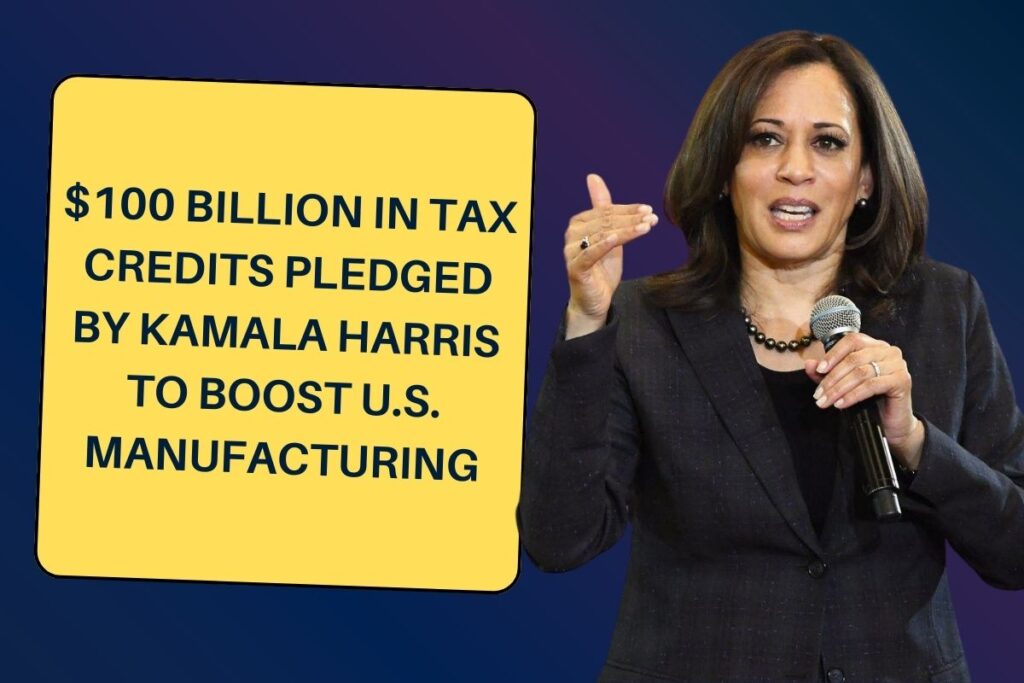Vice President Kamala Harris presented her $100 billion proposal to support middle-class Americans, help American industry, and compete with China. In order to expand on her predecessor’s major investment measures, such as the Inflation Education Act and the Chips and Science Act, Harris stated that her future administration would develop a “America Forward” agenda.
According to a fact sheet released by the campaign, the plan would promote investments in manufacturing, energy, and agricultural communities while also providing new tax credits based on how workers are treated and if they have the freedom to form a union. Her goals included cutting red tape, increasing domestic production of vital minerals like aluminum and lithium, supporting groups working on apprentice ships and other training opportunities, and doing away with needless degree requirements for federal employment. The Harris campaign asserts that the money from international tax reforms will cover the $100 billion cost of her plan.
$100 Billion in Tax Credits Pledged by Kamala Harris to Boost U.S. Manufacturing
US Vice President Kamala Harris outlined the economic platform she intends to pursue in the event that she is elected to the White House in November. During his speech at the PEC in Pennsylvania, Harris presented a plan to invest $100 billion in new projects aimed at increasing manufacturing and employment. Harris also suggested raising taxes on large corporations while lowering taxes on small businesses and house builders. She also criticized the outgoing president Donald Trump for favoring wealthy over the middle class.
The U.S. views the need for these credits to compete with China as a means of safeguarding American jobs and national security and it will benefit companies in a number of industries. This comprises semiconductor manufacturers, sustainable energy startups, artificial intelligence companies, and data centers. “The next generation of breakthroughs from advanced batteries to geothermal to advanced nuclear are not just invented, but built here in America by American workers,” according to Harris, who added the investments will assure. And by providing tax credits for the expansion of excellent union employment in steel, iron, and manufacturing areas like this one in the Mon Valley, we will invest in the industries that created Pittsburgh the Steel City.
‘Cut Red Tape’: Harris Proposes USD 100 B To Rebuild America’s Industrial Base
In order to boost major sectors of the American economy, Kamala Harris suggested investing $100 billion. Politico claims Harris discussed how critical it is to prepare the American labor force for emerging businesses. By the conclusion of her first term, she aimed to treble the number of registered apprenticeships and promised to remove pointless degree requirements for 500,000 government posts.
Measures to expedite the construction process for new industrial projects are included in the proposal. The focus of Harris’ economic plan, which was released on Wednesday, was “Building More and Faster by Cutting Red Tape.” It recognized the difficulties posed by the long lead times and high prices of construction in USA. She pledged to change the regulatory procedures in order to expedite project development while preserving community involvement and environmental concerns.

As Trump delves farther into populism, Harris offers a “capitalist” argument to strengthen the economy.
- Vice President Kamala Harris retaliated against Republican nominee Donald Trump’s accusations that she is pushing “communist” ideals by promising to create an economy that supports small businesses and the middle class. The Democratic candidate declared that she “would take good ideas from wherever they come” while outlining her support for increased house ownership and promising to double the number of individuals taught in registered apprenticeships. She made these statements before the Pittsburgh Economic Club in battleground Pennsylvania.
- Visited a furniture maker in Mint Hill, North Carolina, just over an hour before her speech, Trump presented his own opposing economic vision. In addition to promising to enact tariffs high enough to cause a “exodus” of auto production employment from South Korea, Germany, and Japan, he justified his proposal for a special lower tax rate for American manufacturers.
- The rival addresses from the two contenders demonstrated how they are refining their economic platforms for battleground state electors. Both are making their strongest arguments to a public that is still concerned about the state of the economy while attempting to refute criticism. While Harris emphasizes the need of assisting the middle class and businesses, Trump is more concerned with the idea of American superiority over international rivals.
- If the former president were elected, the corporation tax rate for businesses that produce goods domestically would decrease from 21% to 15%. The Republican candidate claimed he was being targeted internationally because he supported tariffs as high as 20%.
- Harris’s commitments add on her earlier ones, which included tax breaks for low-income families, initiatives to combat excessive prescription costs, and opposition to Wall Street’s house-buying frenzy. Harris has stated that raising the corporation tax rate and additional taxes on the wealthiest Americans would pay for a large portion of her plans.
- Increasing tariffs, which Trump claims would balance the cost savings from cutting taxes on individuals and businesses, is how he plans to combat China and advance American manufacturing. Trump’s plans might result in tariffs on Chinese imports rising by up to 50%, significantly increasing the cost of those products for consumers.
